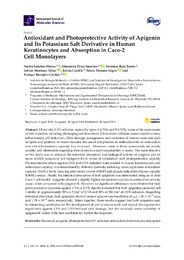Título :
Antioxidant and Photoprotective Activity of Apigenin and its Potassium Salt Derivative in Human Keratinocytes and Absorption in Caco-2 Cell Monolayers |
Autor :
Sánchez-Marzo, Noelia 
Pérez Sánchez, Almudena
Ruiz Torres, Verónica
Martínez Tébar, Adrián 
Castillo, Julián
Herranz López, María
Barrajón-Catalán, Enrique  |
Editor :
MDPI |
Departamento:
Departamentos de la UMH::Ingeniería |
Fecha de publicación:
2019-04 |
URI :
https://hdl.handle.net/11000/34405 |
Resumen :
Ultraviolet (UV) radiation, especially types A (UVA) and B (UVB), is one of the main causes of skin disorders, including photoaging and skin cancer. Ultraviolent radiation causes oxidative stress, inflammation, p53 induction, DNA damage, mutagenesis, and oxidation of various molecules such as lipids and proteins. In recent decades, the use of polyphenols as molecules with an antioxidant and anti-inflammatory capacity has increased. However, some of these compounds are poorly soluble, and information regarding their absorption and bioavailability is scarce. The main objective of this study was to compare the intestinal absorption and biological activity of apigenin and its more soluble potassium salt (apigenin-K) in terms of antioxidant and photoprotective capacity. Photoprotective effects against UVA and UVB radiation were studied in human keratinocytes, and antioxidant capacity was determined by different methods, including trolox equivalent antioxidant capacity (TEAC), ferric reducing antioxidant power (FRAP) and oxygen radical absorbance capacity (ORAC) assays. Finally, the intestinal absorption of both apigenins was determined using an in vitro Caco-2 cell model. Apigenin showed a slightly higher antioxidant capacity in antioxidant activity assays when compared with apigenin-K. However, no significant differences were obtained for their photoprotective capacities against UVA or UVB. Results indicated that both apigenins protected cell viability in approximately 50% at 5 J/m2 of UVA and 90% at 500 J/m2 of UVB radiation. Regarding intestinal absorption, both apigenins showed similar apparent permeabilities (Papp), 1.81 × 10−5 cm/s and 1.78 × 10−5 cm/s, respectively. Taken together, these results suggest that both apigenins may be interesting candidates for the development of oral (nutraceutical) and topical photoprotective ingredients against UVA and UVB-induced skin damage, but the increased water solubility of apigenin-K makes it the best candidate for further development.
|
Palabras clave/Materias:
flavonoid
apigenin
photoprotection
UV radiation
antioxidant
keratinocytes
absorption |
Área de conocimiento :
CDU: Ciencias puras y naturales: Generalidades sobre las ciencias puras |
Tipo de documento :
info:eu-repo/semantics/article |
Derechos de acceso:
info:eu-repo/semantics/openAccess
Attribution-NonCommercial-NoDerivatives 4.0 Internacional |
DOI :
https://doi.org/10.3390/ijms20092148 |
Publicado en:
IJMS Volume 20 Issue 9 (2019) |
Aparece en las colecciones:
Artículos - Ingeniería
|
 La licencia se describe como: Atribución-NonComercial-NoDerivada 4.0 Internacional.
La licencia se describe como: Atribución-NonComercial-NoDerivada 4.0 Internacional.
.png)
